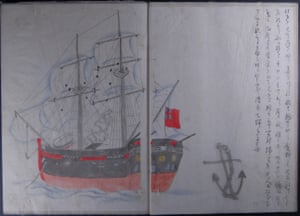about the 'transportation' of the English and Irish 'criminal
classes' to Australia and Van Diemen's Land/Tasmania (1787-
1868.)//
Tasmanian Devil click for previous TNT item in this vein and
more on Macquarie Harbor penal colony, in particular.
Recent corroboration from Japan click here for The Guardian
story from May, 2017.

Contemporary Japanese painting that seems to confirm
the appearance of the Cyprus in Japanese waters, 1829-1830.
"In 1828, 31 convicts aboard the Cyrprus brig were being transported
from Hobart, the capital of Van Diemen's Land (Tasmania) to
Macquarie Harbor penal colony on the island's west coast. The
most intrepid of the convicts was a former sailor, William Swallow,
who was a veritable Houdini. In 1810 he had hijacked a schooner in
Port Jackson (Sidney) and been sent to Van Diemen's Land as his
secondary punishment. The ship that took him there, the Deveron,
was disabled in a storm and Swallow, 'remarking that his own life
was of little moment', volunteered to go aloft and cut away a slatting
tangle of broken spars and rigging.

Japanese painting thought to depict William Swallow.
It seems that the Deveron's sailors were so grateful for his courage
in saving the ship that, as soon as Swallow was landed in Hobart,
they smuggled him back on board. Thus he escaped, and got all
the way across the ocean to Rio de Janiero, where he was captured
again by British authorities. Once more, though, he got free and
stowed away on a London-bound boat. But he was finally recognized
in London, arrested and shipped out again to Van Diemen's Land.
Such was the man who, 'confined within a dismal hole' with his fellow
convicts as the Cyprus rode at anchor near the southern tip of Van
Diemen's Land, decided to make a last bid...
To take possession of that brig or else die every man:
The plan it being approv'd upon, we soon retired to rest,
And early next morning, boys, we put them to the test.
Up steps bold Jack Muldeamon, his comrades three more -
We soon disarmed the sentry and left him in his gore:
'Liberty, O liberty! It's liberty we crave -
Surrender up your arms, my boys, or the sea shall be your grave!
After a rush, a scuffle and some shooting, the convicts overpowered
the guard and carried the ship. They put the officer-in-charge,
Lieutenant Carew, over the side along with his wife, the soldiers
and thirteen convicts who had not joined the mutiny. The Cyprus
was heavily laden with stores for Macquarie Harbor, enough to
sustain 400 men for six months, but the convicts gave the 45
castaways a stingy ration - a live sheep, some salt beef, a bag of
biscuits and 30 pounds of flour, with no weapons and no boat.
After prolonged suffering from exposure and starvation, living on
a handful of raw mussels and a quarter-biscuit a day, the castaways
eventually got back to Hobart. They might not have done so without
a convict named Popjoy, who framed up a 12-foot coracle out of
mimosa branches, covered it with hammock canvas - sewn by Mrs.
Carew, who had a needle - and waterproofed it with soap and resin.
Popjoy and Carew sailed this fragile shell twenty miles to Partridge
Island, south of Hobart, where they were saved by a passing ship.
//Ed. Note: more on Popjoy later//
Meanwhile, the Cyprus and her pirates were well away. Swallow
shaped his course for Tahiti, and then turned north for Japan, where
he and his crew landed some time in 1829; seven of the convicts
jumped ship there. Several months later, Swallow and three of his
mates appeared in a skiff off the Chinese trading port of Whampoa.
They had abandoned the Cyprus. Swallow presented himself to
officials in Canton as Captain Waldron of the ship Edward, set on
fire and sunk at sea by the Japanese. In this way, Swallow and
his mates wangled a free passage home to England.
Unfortunately, soon after they sailed, other survivors of the Cyprus
turned up in Canton and Swallow's story began to unravel.
Eventually, Swallow and his mates were arrested in England, and
were identified by Popjoy, who, by a bizarre stroke of colonial ill-luck,
had returned to London after receiving a free pardon for helping save
the castaways at Recherche Bay (at the southern tip of Tasmania). But
Popjoy insisted that Swallow had been forced by his fellow absconders
to navigate the ship, and the court believed him. So, although
Swallow's companions were hanged, he was not. For the third time,
he was forced to go on board a transport and make the long,
lugubrious journey to Australia. It was his last. As soon as he
arrived in Hobart, he was shipped to Macquarie Harbor - and this
time there was no escape. William Swallow eventually died of
tuberculosis in the penal colony of Port Arthur, near Hobart, to
which he had been transferred when Macquarie Harbor was closed
down in 1834.

Penal colonies in Van Deimen's Land/Tasmania circa 1830.

Hiç yorum yok:
Yorum Gönder